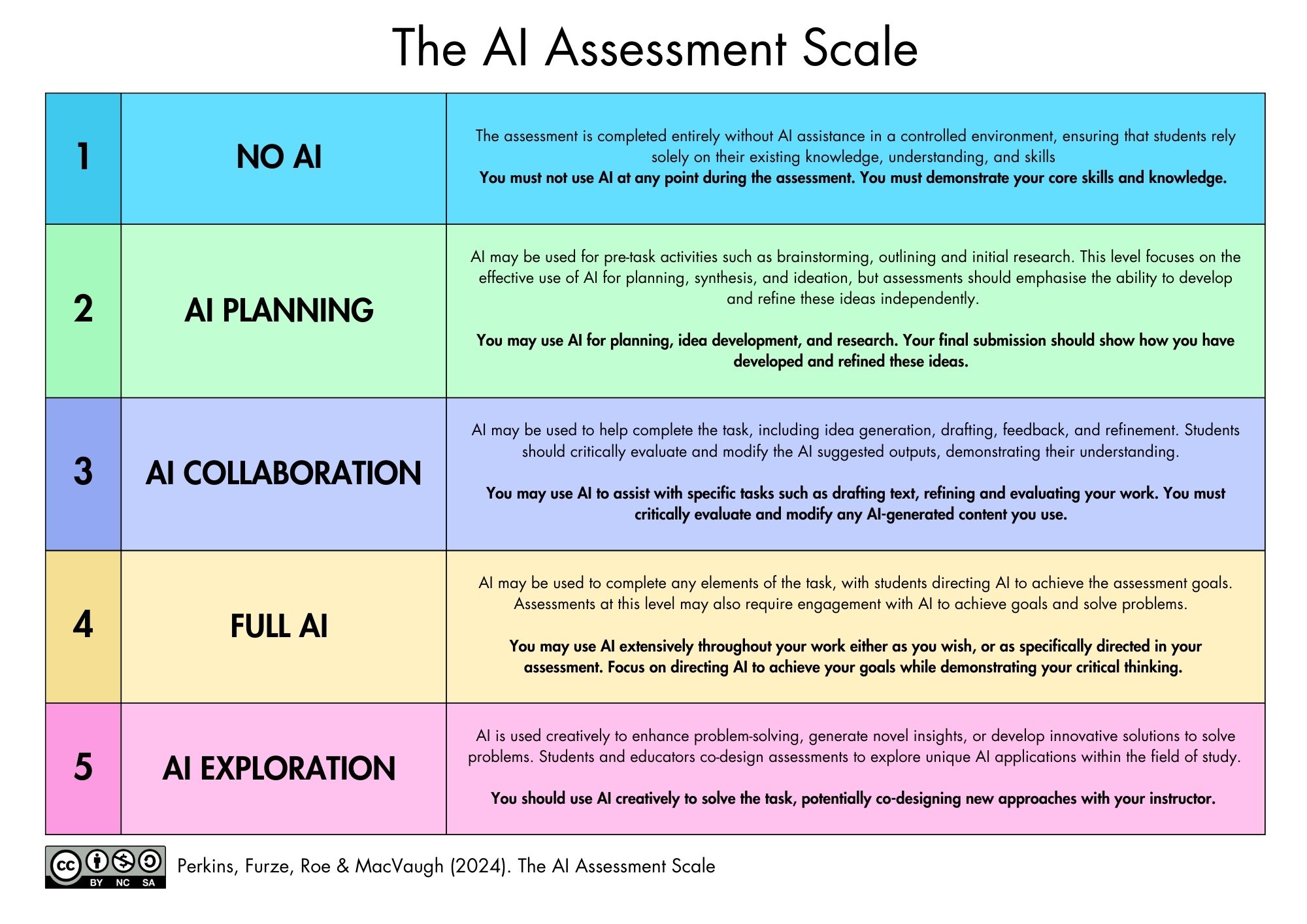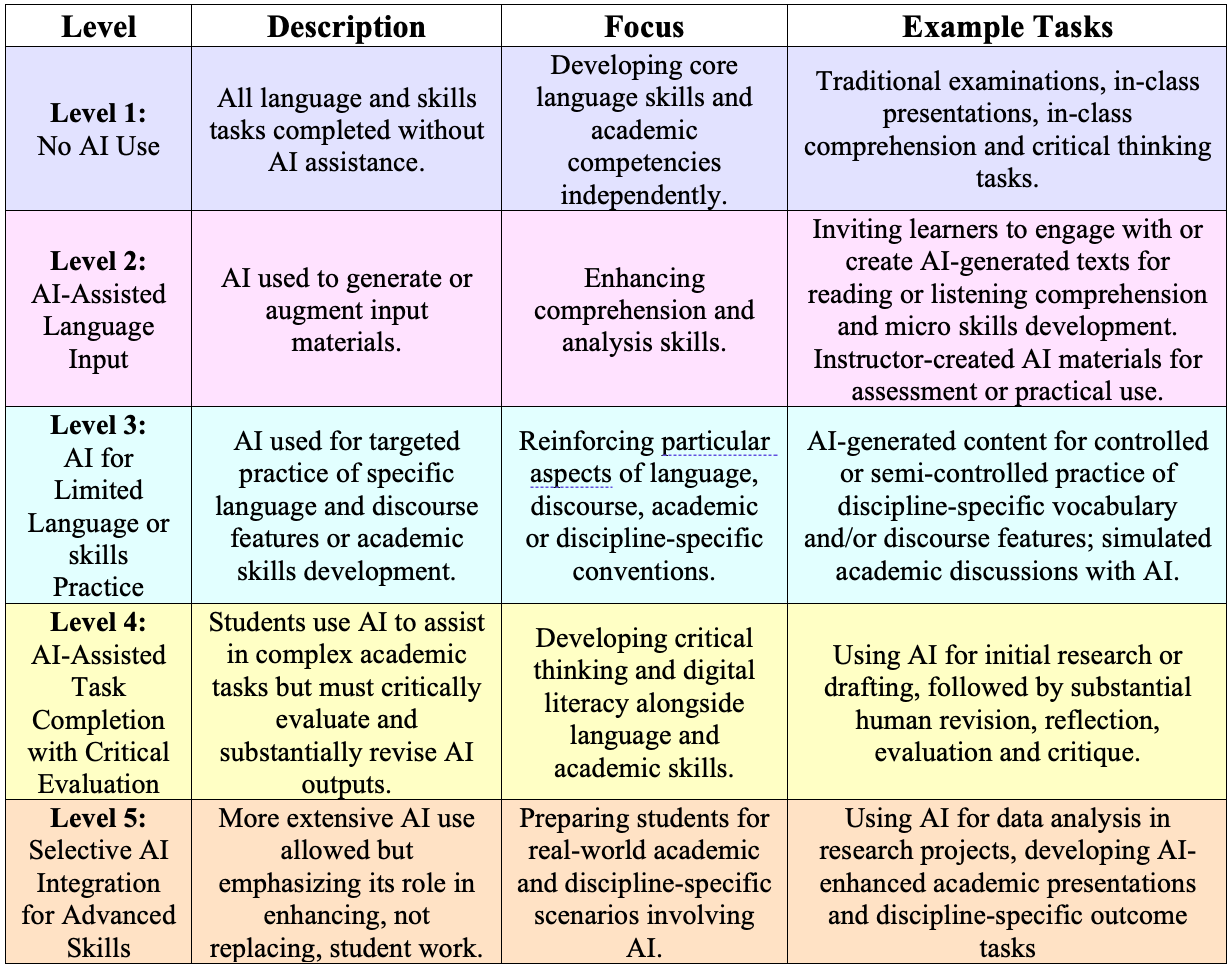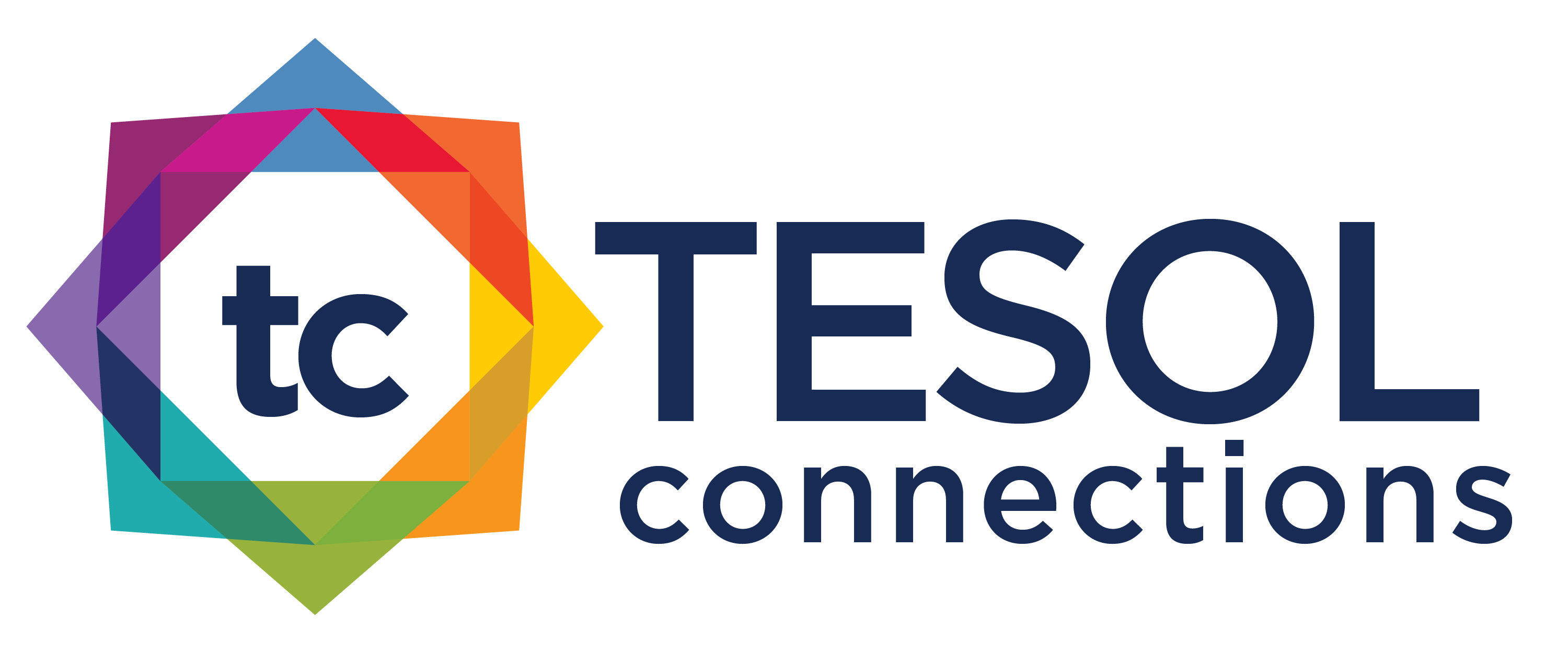KEEPING ENGLISH LANGUAGE PROFESSIONALS CONNECTED
The AI Assessment Scale: A Practical Framework for TESOL Educators in the Age of ChatGPT
by Jasper Roe, Leon Furze, Mike Perkins, Christina Kitson | 17 Mar 2025

Recent advances in generative artificial intelligence (AI) have transformed education globally, with a significant impact on English language teaching. Since the release of ChatGPT in late 2022, TESOL educators have grappled with questions regarding academic integrity, assessment design, and the role of AI in language learning. Although some institutions initially attempted to ban these technologies, there is growing recognition that AI tools will be an integral part of students' academic and professional lives (Perkins, Furze, et al., 2024).
Against this backdrop, the AI Assessment Scale (AIAS) was developed as a practical framework to help educators structure and guide students’ use of AI tools in assessments. Originally developed to address urgent concerns about academic integrity, the AIAS has evolved into a flexible tool that supports transparent dialogue between teachers and students about appropriate AI use (Perkins, Roe, & Furze, 2024).
Before diving into how TESOL educators can use the AIAS to help manage their students’ use of AI tools, we present the story of how we developed the scale and outline its basic structure.
Understanding the AI Assessment Scale
The AIAS was designed to provide educators with a structured approach to integrating AI into assessment and instruction while maintaining transparency, academic integrity, and pedagogical soundness. The first version, outlined in the Journal of University Teaching and Learning Practice, introduced a five-level framework, from no AI use to the full integration of AI tools (Perkins, Furze, et al., 2024).
However, as generative AI capabilities rapidly evolved, it became clear that the framework needed to be more flexible. The revised version, currently published as a preprint (Perkins, Roe, & Furze, 2024), incorporates feedback from global educators, including those from the disciplines of TESOL and English language education. This version also expands the scope to reflect increasingly capable generative AI applications.
Notably, the revised version of the AIAS introduced AI Exploration as a new category, recognizing that AI is no longer just a writing tool but a fundamental component of digital literacy in language learning. AI Exploration refers to tasks in which AI must be used to address a task.
The AIAS consists of five levels (see Figure 1). For any assessment activity, teachers can specify (in the task instructions, e.g.) which level of the AIAS is allowed. The levels of engagement with AI are as follows:
Level 1 (No AI) asks students to complete assessments without AI assistance and in controlled environments.
Level 2 (AI Planning) allows the use of AI for pretask activities, such as brainstorming and research.
Level 3 (AI Collaboration) permits AI assistance for specific tasks under careful guidance.
Level 4 (Full AI) enables extensive AI use throughout the assessment process.
Level 5 (AI Exploration) encourages the creative application of AI technologies to solve new problems.

Figure 1. The AI Assessment Scale.
Practical Applications in TESOL
In the English language classroom, the AIAS is not only relevant to assessment, but also can be used as a framework to structure different types of language learning activities and assignments. This approach recognises that—rather than banning AI tools altogether—educators and students can find productive ways to use these tools. The AIAS enables English language teachers to communicate their expectations clearly to students, administrators, and colleagues.
The application of the AIAS in classroom contexts, including English as a foreign language (EFL) and English for academic purposes (EAP), has demonstrated key benefits and challenges of the scale.
In practice, we have observed notable differences between the two contexts:
English as a Foreign Language
In this context, AI tools have been found particularly useful for enhancing fluency and accuracy, helping learners at various proficiency levels to structure their writing. Research indicates that AI-assisted planning and editing activities (AIAS Levels 2 and 3) have allowed students to refine their writing skills while maintaining their voice. Additionally, AI collaboration (Level 4) encourages critical engagement with AI-generated content, supporting learners in evaluating coherence, lexical appropriateness, and cultural relevance (Roe et al., 2025).
English for Academic Purposes
In this context, the AIAS framework has been adapted to address academic writing conventions, research synthesis, and source integration. AI-assisted feedback mechanisms (Level 3) have supported self-regulation in the writing process by reducing dependence on instructor feedback while increasing engagement with revision strategies. AI exploration (Level 5) introduces students to multimodal academic tasks, allowing them to work with AI-generated summaries, research insights, and structured outlines to build complex academic arguments (Roe et al., 2024).
 A major takeaway from both contexts is that using the AIAS fosters metacognitive awareness, helping learners transition from passive AI consumers to active AI collaborators. Although AI offers efficiency, students still require explicit instruction on how to evaluate AI output, refine responses, and ensure ethical AI use in their writing. This aligns with the growing call for critical AI literacy to become an integral part of TESOL pedagogy.
A major takeaway from both contexts is that using the AIAS fosters metacognitive awareness, helping learners transition from passive AI consumers to active AI collaborators. Although AI offers efficiency, students still require explicit instruction on how to evaluate AI output, refine responses, and ensure ethical AI use in their writing. This aligns with the growing call for critical AI literacy to become an integral part of TESOL pedagogy.
Ultimately, our research shows that the AIAS can be particularly valuable in EFL and EAP contexts. For example, for assessments and assignments at AIAS Level 2, students might use AI tools to
-
- generate vocabulary lists for specific academic contexts,
- brainstorm ideas for writing tasks, and
- understand complex reading passages.
At AIAS Level 3, common applications include
-
- getting feedback on draft writing,
- practicing dialogue with AI conversation partners, and
- analyzing academic text structures.
Adapting the Scale for Your Classroom
A key benefit of the AIAS is its flexibility. Language teachers can adapt the framework to suit their specific teaching contexts, whether working with beginners or advanced learners. For instance, a Level 2 task might involve using AI to help plan a presentation, whereas a Level 4 activity could include using AI tools to create and analyze academic writing samples.
Roe, Perkins, and Tregubova (2024) demonstrated how the AIAS can be modified for EAP settings, where tasks often focus on developing both language proficiency and academic skills (see Figure 2).

Figure 2. The AI Assessment Scale adapted for English for academic purposes (EAP).
A significant advantage of the AIAS is that it provides structured opportunities for students to interact with AI in ways that prioritize learning objectives, relieving students’ uncertainty about permitted AI use. The scale's adaptable design offers instructors considerable flexibility to customize its language according to their specific teaching context and students' proficiency levels. Teachers can tailor the framework to specify eligible assignments, authorized AI tools, and additional requirements, such as submitting AI interactions for assessment purposes.
Key Takeaways
The future of assessment in English language teaching will likely involve the increasing integration of AI tools. However, this integration must be carefully and systematically planned. The AIAS provides a practical framework for managing this transition, helping teachers design assessments that acknowledge the presence of AI while maintaining pedagogical validity—a key challenge facing educators (Dawson et al., 2024).
For TESOL educators considering implementing the AIAS, here are six key takeaways:
-
- Start gradually, perhaps beginning with Level 2 activities.
- Don’t limit the AIAS to just assessment tasks; try using it to structure different learning activities.
- Be explicit about expectations for AI use in different tasks.
- Focus on developing students' critical evaluation skills.
- Consider how AI tools can support, rather than replace, language learning.
- Ensure that AI use reflects student proficiency level and language understanding.
- Start gradually, perhaps beginning with Level 2 activities.
Conclusion
AI is here to stay, and the TESOL community must find ways to understand its potential while maintaining pedagogical integrity. The AIAS offers a structured approach to AI integration and helps educators understand the implications of this technology. By using AI for planning, editing, and collaboration while also fostering critical literacy, TESOL professionals can prepare students for these increasingly ubiquitous and capable technologies without compromising authentic language learning.
The AIAS also offers TESOL educators a practical way to address the challenges and opportunities presented by AI in language teaching. By providing clear guidelines for AI use, academic integrity can be maintained while acknowledging the reality of these tools in students' lives. The scale can act as a conversation starter between students and faculty about appropriate, transparent AI use. As these technologies continue to develop, frameworks such as the AIAS will become increasingly valuable for structuring effective language teaching and assessment.
References
Dawson, P., Bearman, M., Dollinger, M., & Boud, D. (2024). Validity matters more than cheating. Assessment & Evaluation in Higher Education, 49(7), 1005–1016. https://doi.org/10.1080/02602938.2024.2386662
Perkins, M., Furze, L., Roe, J., & MacVaugh, J. (2024). The Artificial Intelligence Assessment Scale (AIAS): A framework for ethical integration of generative AI in educational assessment. Journal of University Teaching and Learning Practice, 21(06). https://doi.org/10.53761/q3azde36
Perkins, M., Roe, J., & Furze, L. (2024). The AI Assessment Scale revisited: A framework for educational assessment (Version 1). arXiv. https://doi.org/10.48550/ARXIV.2412.09029
Roe, J., Perkins, M., & Furze, L. (2025). From assessment to practice: Implementing the AIAS framework in EFL teaching and learning (Version 1). arXiv. https://doi.org/10.48550/ARXIV.2501.00964
Roe, J., Perkins, M., & Tregubova, Y. (2024). The EAP-AIAS: Adapting the AI Assessment Scale for English for academic purposes (Version 1). arXiv. https://doi.org/10.48550/ARXIV.2408.01075
Also In This Issue
‣ Preparing Multilingual Learners for Real-World Media in English
‣ Spotlight on the 2025 TESOL Teacher of the Year: Osman Solmaz
‣ 10 Tips for a Meaningful TESOL International Convention Experience
‣ Supporting Every Learner: Digital Tools for Accessible ELT Classrooms
Recent TESOL Blogs
‣ 3 Reasons (and Ways!) to Embrace Mother Languages in the Classroom
‣ Unlocking Comprehension: How to Plan a Unit Before Reading Begins
‣ What’s in a Name: Why You Should Learn How to Pronounce Your Students’ Names
‣ Join Us in Long Beach! Research Professional Council Events at TESOL 2025

